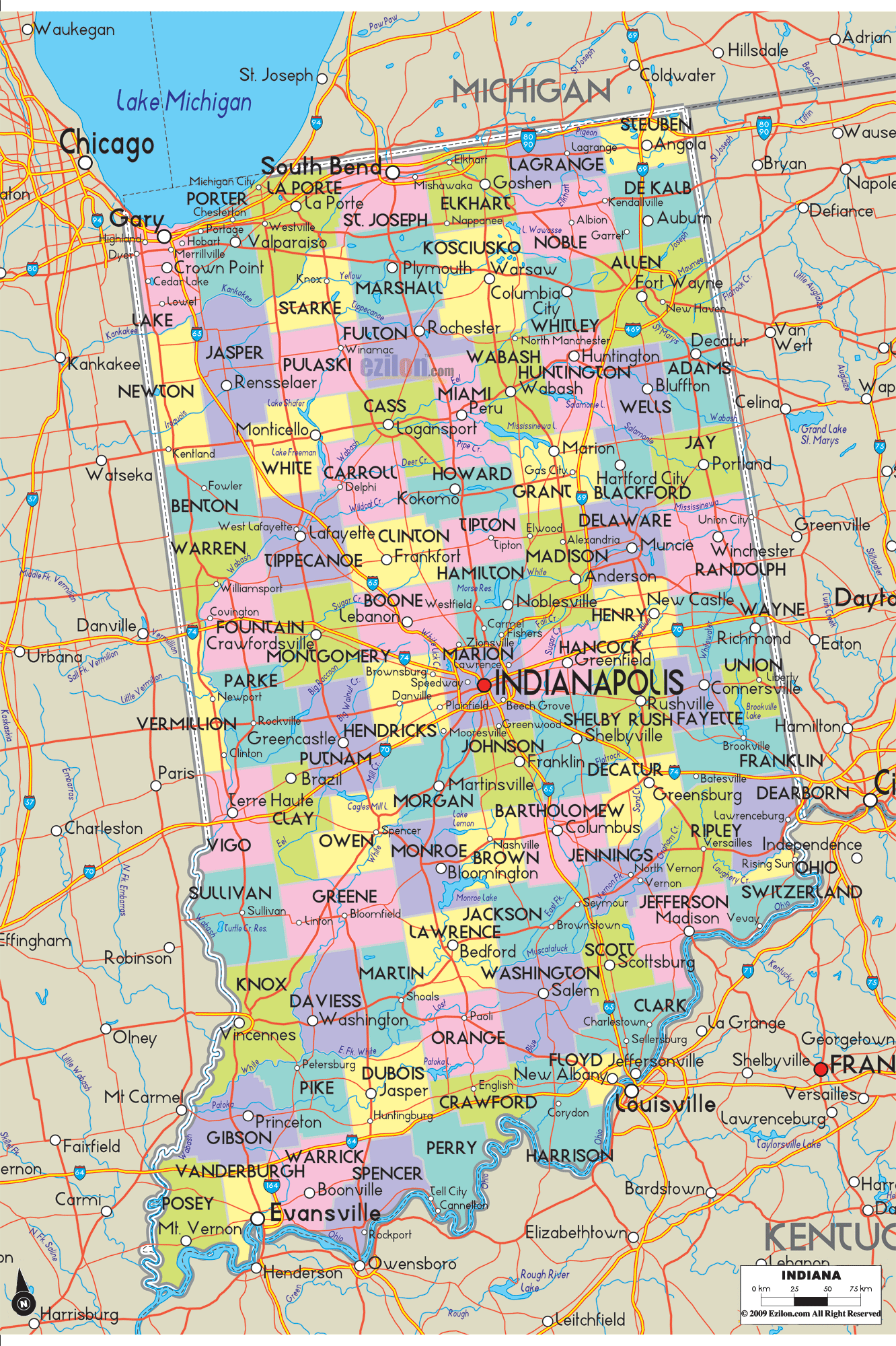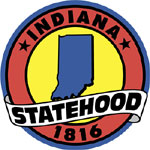

Description: Detailed large map of Indiana State, USA showing cities, towns, county formations, roads highway, US highways and State routes.
 Introduction:
Introduction:
Beholding a rich historical legacy intertwined with the vibrant thread of modernism, the state of Indiana is a microcosm of the essence of America. As a realm that saw the rhythm of Native American cultures before being touched by European nature, Indiana has grown over the centuries to become a hub of economic activities, cultural amalgamation, and natural splendor.
The Map of Indiana encapsulates this enchanting blend of past and present, showcasing not just the geographical boundaries but also the spirit of Indiana through its cities, towns, counties, and intricate network of roads. This map is an elaborate guide for those seeking to uncover the secrets of the Hoosier State, offering a clear depiction of its vast expanses.
A Journey through Heritage: The eastern region of Indiana is a gateway to the state's rich historical tapestry. As viewers traverse the map from east to west, they initially encounter Wayne County, where the city of Richmond stands as a testament to the state's cultural heritage. The Old National Road, part of U.S. Route 40, runs through this historic city, providing a physical and historical pathway connecting the east to the west.
Further south, one enters Union County with its quaint town of Liberty, offering a glimpse of rural Indiana's charm. The map also delineates the intricate network of state highways like State Road 44 that weave through these towns and counties, binding them in a common Hoosier tradition.
The Lakes' Whisper: As depicted on the map, the northern part of Indiana cradles the essence of the Great Lakes region. As one navigates through the counties of St. Joseph and Elkhart, the cities of South Bend and Elkhart emerge as beacons of education, industry, and natural beauty. The St. Joseph River, twisting and turning through the landscape, is beautifully depicted on the map.
The map also sheds light on the network of roads, notably U.S. Route 20 and State Road 19, that facilitate movement across this region, offering a visual guide for anyone wanting to explore the lakes and rivers that adorn northern Indiana.
The Call of the Wabash: Western Indiana, as portrayed on the map, houses the serene flow of the Wabash River, which meanders through the counties, carving out beautiful landscapes. In Vigo County's Terre Haute, vital education and a vivid historical background are notable features.
The map demonstrates the grid of roadways, with U.S. Route 41 being a notable mention, acting as arteries nourishing the far reaches of the western part of the state.
The Veins of Tradition and Nature: The southern segment of the Indiana map is where the traditional beats of the state fuse with breathtaking natural vistas. The counties of Monroe and Brown, with cities like Bloomington and Nashville, respectively, are places where tradition meets modernity.
The map guides the viewers along State Road 46 and State Road 135 pathways, allowing them to plan their journey through the rolling hills and into the soul of Indiana's folkloric heartland.
Heart of the Hoosier: The central portion is where the pulse of Indiana beats the strongest. As highlighted on the map, the city of Indianapolis in Marion County is the state's capital and the epicenter of its cultural, economic, and political life. The Map of Indiana allows a close inspection of the network of roads like Interstate 65, Interstate 70, and Interstate 465 that form the region's lifeblood.
The surrounding counties of Hamilton, Hendricks, and Johnson further enrich the central region with their unique blend of urban sophistication and rural simplicity.
The Vital Veins: The roadways of Indiana, as meticulously marked on the map, are the veins that keep the lifeblood of connectivity flowing across the state. Major highways like Interstate 69, which runs from the north to the south, and Interstate 74, traversing from east to west, are particularly highlighted, indicating the ease of transit between the different parts of the state.
According to recent statistics, Indiana houses a population of around 6.8 million. The Map of Indiana provides a spatial understanding of how this population is distributed across various cities and counties, facilitating a deeper insight into the demographic structure of the state.
The racial and ethnic composition of Indiana is a reflection of its inclusive ethos. The breakdown is as follows:
White (non-Hispanic): This group forms the most prominent racial demographic, comprising about 79.6% of the population.
Black or African American: They form a significant % of the state's demographic fabric, with around 9.8%.
Hispanic or Latino: This vibrant community constitutes about 7.3% of the population, adding to the cultural diversity of Indiana.
Asian: Contributing to the state's global identity, the Asian community forms about 2.5% of the population.
Other races or mixed races: Comprising around 1.8% of the population, they add to the multifaceted racial and ethnic mosaic of Indiana.
Indiana's aerial gateways are critical connectors for both its residents and visitors. The Map of Indiana meticulously marks the locations of these airports, providing a visual guide for travelers. Some notable airports include:
Indianapolis International Airport (IND): Located in the capital city, this airport is the largest in the state and is a significant hub for domestic and international flights. Its location is prominently marked on the map, indicating its significance.
Fort Wayne International Airport (FWA): Situated in Allen County, this airport is a crucial aerial gateway for the northeastern part of Indiana. The map provides clear directions to its location, ensuring ease of access for travelers.
South Bend International Airport (SBN): This airport in St. Joseph County facilitates connectivity for the northern region of Indiana. Its strategic location is well-detailed on the map.
Evansville Regional Airport (EVV): Serving the southwestern part of Indiana, this airport is a vital node in the state's aerial network. The map showcases its location, guiding individuals traveling to or from this region.
Indiana's natural heritage finds a splendid expression in its state parks. Each of these natural havens is a tableau of the state's ecological diversity and historical richness. The Map of Indiana is a meticulous planner's tool, indicating the exact locations of these parks along with the adjoining roads for easier access. Below is an exploration of some of these verdant havens, their precise geographical areas, and nearby road networks.
· Location: Nestled in the rolling hills of Brown County in Nashville, Indiana.
· Access Roads: State Roads 46 and 135 provide straightforward access to this lush retreat.
· Brief: Known as the "Little Smokies" due to its reminiscent aesthetics of the Great Smoky Mountains, this park is famed for its autumnal foliage, scenic vistas, and diverse trails.
· Location: Situated along the southern tip of Lake Michigan in Chesterton, Indiana.
· Access Roads: You can reach the park via I-94, U.S. Route 12, and Indiana State Road 49.
· Brief: Home to some of the state's most diverse flora, fauna, and majestic dunes, this park is a paradise for birdwatchers and beach lovers.
· Location: Located in the northeastern corner of Indiana near Angola.
· Access Roads: Accessible via I-69 and Indiana State Road 127.
· Brief: Known for its winter activities, Pokagon features toboggan runs and cross-country skiing trails amidst a beautiful natural setting.
· Location: Situated near Marshall, Indiana, in Parke County.
· Access Roads: Indiana State Road 47 and U.S. Route 41 provide easy access to this rugged, picturesque park.
· Brief: With ancient sandstone ravines and lush old-growth forests, it's a place where visitors can step back in time while exploring nature's beauty.
· Location: Located near Mitchell in Lawrence County.
· Access Roads: Accessible through Indiana State Road 60.
· Brief: Home to a working grist mill and a pioneer village, this park offers a unique blend of natural and artificial wonders.
· Location: Positioned near Spencer in Owen County.
· Access Roads: Accessible via Indiana State Road 46.
· Brief: As Indiana's first state park, it showcases beautiful limestone canyons, a flowing creek, and scenic waterfalls.
· Location: Located in the capital city of Indianapolis.
· Access Roads: Accessible via I-465 and 59th Street.
· Brief: An oasis of green in urban Indianapolis, this park offers recreational activities, picnicking spots, and a glimpse into the state's military history.
· Location: Situated near Madison, Indiana, in Jefferson County.
· Access Roads: Indiana State Road 56 leads directly to this haven of waterfalls and rugged terrain.
· Brief: Known for its waterfalls, rugged terrain, and fossil-finding opportunities, it's a thrilling spot for the outdoor enthusiast.
The Map of Indiana is more than just a geographical representation; it's a narrative crafted meticulously to offer a comprehensive insight into what makes Indiana a state of diverse offerings. The text presents the place with a vibrant and welcoming portrayal, including river flow and urban activity details.
It motivates people to engage in exploration and education of the area. Through this map, the heartbeats of the countless individuals who call Indiana home resonate, echoing the ethos of unity, tradition, and progress that defines the Hoosier State.

Physical Map of Indiana
Physical map and map image of Indiana.

Regional Directory of Canada
Information and guide about Canada and website listing.

Regional Directory of United States of America
Information and guide about United States of America and websites with American topics.

Regional Directory of Europe
Information and guide about Europe and websites with European topics.

Regional Directory of Australia
Information and guide about Australia and websites with Australian topics.